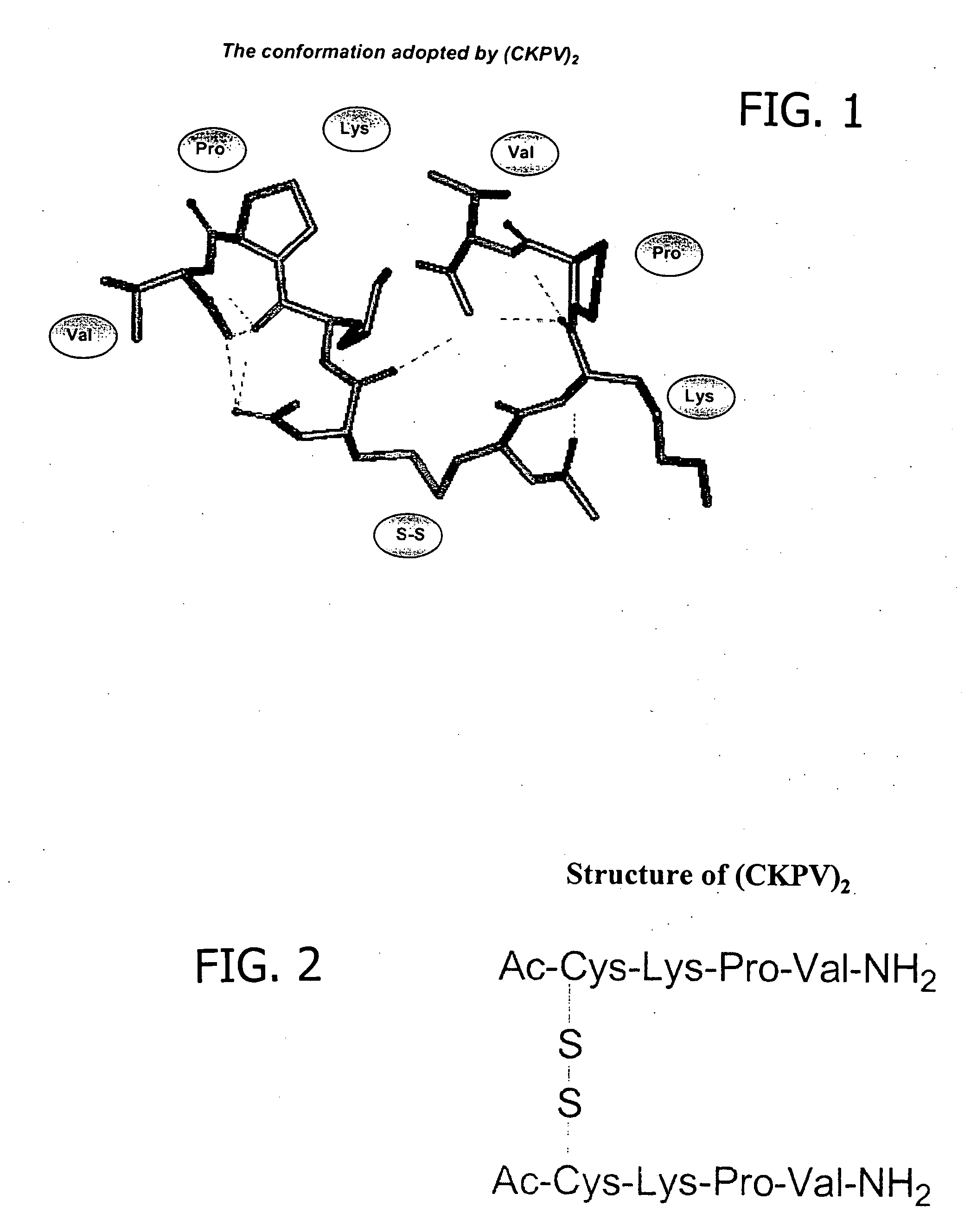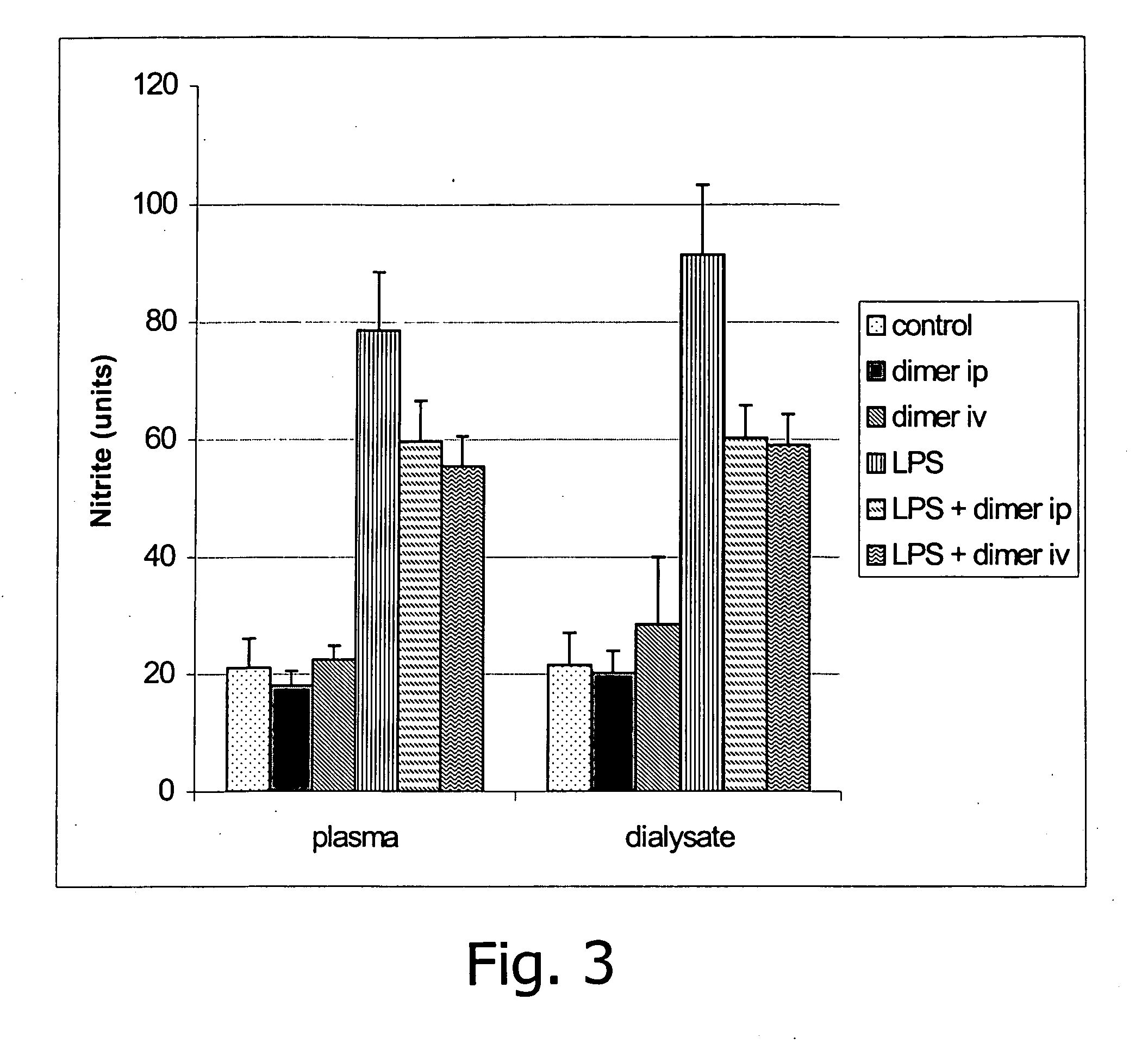Anti-inflammatory/anti-microbial peptides for use in dialysis
a technology of anti-inflammatory/anti-microbial peptides and dialysis, which is applied in the direction of peptides/protein ingredients, drug compositions, peptides, etc., can solve the problems of thrombotic or infiltrative blockage of access, few suitable candidates match with potential kidney donors, and many of the complications associated with each may be life-threatening, so as to enhance the protective effect of locking solutions
- Summary
- Abstract
- Description
- Claims
- Application Information
AI Technical Summary
Benefits of technology
Problems solved by technology
Method used
Image
Examples
example i
Dialysate Containing Anti-Microbial and Anti-Inflammatory Peptides Used in Mice
[0092] At time 0, 15 ml of dialysis fluid was administered to mice with or without lipopolysaccharide (LPS), a known irritant from bacterial cell walls, and with or without intravenous (IV) KPV dimer (SEQ ID NO: 4) or NDP (SEQ ID NO: 7) administration. The dosage of all peptides administered in the fluid, (KPV dimer (SEQ ID NO: 4) or NDP (SEQ ID NO: 7)), was 10−5 M. The same amount was given IP. Seven hours later the animals were sacrificed and blood and peritoneal dialysis fluid removed for analysis.
[0093] Important findings relate to nitrite and are shown in FIG. 3. Nitrite is used as an estimate of nitric oxide production in plasma and dialysate. This is a method to estimate inflammation in the plasma compartment and the peritoneal sack. These compartments are intimately related and changes in concentration generally occur in parallel. The graph depicted in FIG. 3 further identifies sub-units of plas...
example ii
[0097] To demonstrate the protective effect of the KPV dimer on peritoneal and systemic inflammation caused by endotoxin in rats during PD, an in vivo dialysis study was performed. Similar to the above Example, the goal of the study was to learn if the KPV dimer might be useful in controlling inflammation associated with endotoxin in the peritoneal space when the peptide is incorporated in dialysis fluid.
[0098] Acute peritonitis was induced in male Wistar rats (200-220 g) by adding lipolysaccharide (LPS, 5 μg / ml) to the dialysis fluid. the KPV dimer was either added to PD fluid or given iv. Rats (n=6 per group) received either: a) 15 ml dialysis fluid; or b) dialysis fluid plus the KPV dimer 140 μg; or c) dialysis fluid plus LPS; or c) dialysis fluid plus LPS 5 μg / ml and the KPV dimer 140 μg; or d) dialysis fluid plus LPS 5 μg / ml and the KPV dimer 140 μg given iv. After 7 hours rats were sacrificed under ether anesthesia and the abdomen incised.
[0099] ...
example iii
Treating Bacteria and Fungi with Anti-Microbial and Anti-Inflammatory Peptides
[0103] The following microorganisms were used in the Example: Candida albicans (ATCC 10231); Enterococcus faecalis (MDR) (ATCC 51299); Escherichia coli (ATCC 11229); Pseudomonas aeruginosa (ATCC 9027); Staphylococcus aureus (ATCC 6538); Staphylococcus epidermidis (ATCC 12228); and Streptococcus pyogenes Group A (ATCC 19615). These organisms were subcultured onto blood agar plates and incubated for 16-24 hours at 35±2° C. An inoculated needle or loop was touched to each of four or five well isolated colonies of the same morphological type, and the inoculum inoculated into 5 mL of MHB.
[0104] The broth cultures were then allowed to incubate at 35±2° C. until turbidity appeared (usually 2 to 5 hours). The turbidity of actively growing broth cultures was then adjusted with saline or broth to obtain a turbidity visually comparable to that of a 0.5 McFarland Standard prepared by adding 0.5 mL of 0.048 M BaCl2 (...
PUM
| Property | Measurement | Unit |
|---|---|---|
| volume | aaaaa | aaaaa |
| volume | aaaaa | aaaaa |
| length | aaaaa | aaaaa |
Abstract
Description
Claims
Application Information
 Login to View More
Login to View More - R&D
- Intellectual Property
- Life Sciences
- Materials
- Tech Scout
- Unparalleled Data Quality
- Higher Quality Content
- 60% Fewer Hallucinations
Browse by: Latest US Patents, China's latest patents, Technical Efficacy Thesaurus, Application Domain, Technology Topic, Popular Technical Reports.
© 2025 PatSnap. All rights reserved.Legal|Privacy policy|Modern Slavery Act Transparency Statement|Sitemap|About US| Contact US: help@patsnap.com



